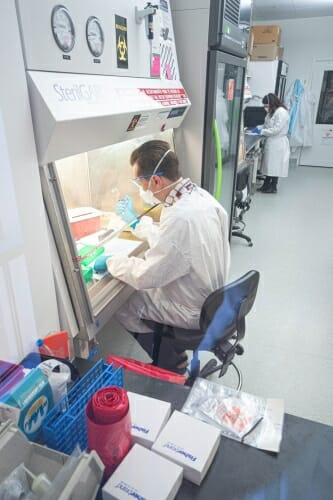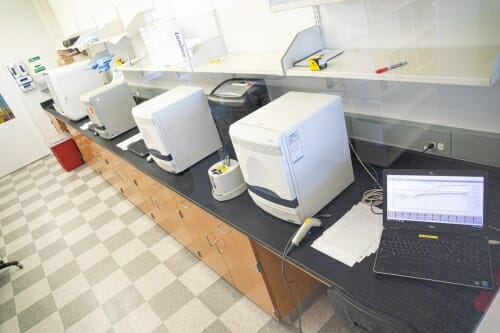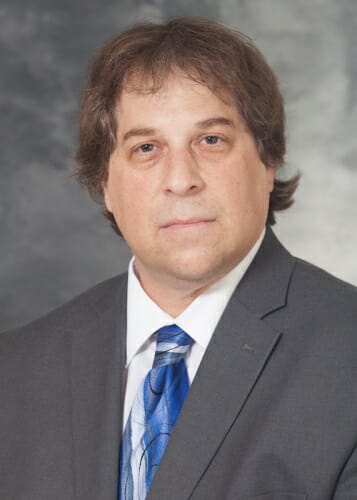Schauer leads COVID-19 testing efforts at hygiene lab
MADISON — As Wisconsin faces unique challenges prompted by the COVID-19 pandemic, a University of Wisconsin–Madison environmental engineering professor has helped a critical testing lab rise to the challenge.
James Schauer, a professor of civil and environmental engineering at UW–Madison, is director of the Wisconsin State Laboratory of Hygiene, which has played a leading role in the state’s testing efforts during the pandemic. A world-renowned expert on air pollution, he often travels internationally and was in Beijing during the 2003 SARS outbreak, which was, like COVID-19, caused by a coronavirus. That experience — marked by poor communication that caused him to learn after he returned to the United States that SARS was present in the region of China he visited — stuck with Schauer and raised alarm bells as COVID-19 began to spread.
“I was certainly paying a lot of attention to what was going on, and checking information on global numbers very early,” Schauer says. “It quickly became clear that this was going to spread to other parts of the world, just from how much more global travel there is now compared to during the SARS outbreak. We then had to recognize that there was no diagnostic testing for COVID-19 anywhere in the world because it was a new virus.”
WSLH served as a primary diagnostic lab for Wisconsin once the U.S. Centers for Disease Control and Prevention developed and distributed a testing method. Schauer says the lab, with its 350 workers, quickly ramped testing capacity up to about 500 samples per day in coordination with hospitals and the Wisconsin Department of Health Services. As of mid-May, Wisconsin’s testing capacity has ballooned to more than 13,500 daily tests at 51 labs across the state.

Erik Reisdorf, lead virologist at the Wisconsin State Laboratory of Hygiene, processes specimens for COVID-19 testing while WSLH Virologist Kyley Guenther prepares to process respiratory virus specimens for the WSLH’s National Influenza Reference Center testing. Photo by John Maniaci, UW Health
“The hygiene lab still plays a coordinating role to support the Wisconsin Department of Health Services where we’re collecting data that’s being reported to the state and local health departments, as well as the CDC, from laboratories around Wisconsin,” Schauer says. “A lot of the surveillance data that we see in the news arises from this network system. WSLH’s role currently is still to do outbreak testing and support public health. So if there were an outbreak in a nursing home or a prison or something where, from a public health point of view, the state needs to go in and test, we’re a major part of that.”
Schauer says the lab is now looking at other test types, such as antibody testing, as a possible means to determine who has been exposed to COVID-19 to better understand how far the coronavirus has spread in Wisconsin. However, he cautions that it’s still unclear which tests are best suited for that work.
Schauer holds a unique position as both an air pollution expert and a leader in the state’s response to the pandemic. COVID-19, as a primarily respiratory disease, crosses boundaries from infectious disease research to some of the challenges facing air pollution researchers, such as air filter efficacy for keeping out contaminants. In part, that relates to the relatively new (to the United States) habit of wearing masks — something Schauer predicts will become more common long-term as COVID-19 ebbs and surges in the population.
“I think sometimes we’re somewhat sheltered in the U.S. from things that happen in other parts of the world,” Schauer says. “One of the things that overlaps with COVID-19 and pollution, from my point of view, is the use of masks. People in the U.S. are often reluctant to wear masks. But in countries where air pollution is dominant, people wear masks all the time. If you were walking down the street in China or Bangladesh, you’d see lots of people wearing masks. They’re not perfect, but they make a difference. It’s part of the defense and can enhance physical distancing efforts that we’re doing.”

COVID-19 testing is performed by polymerase chain reaction (PCR). These instruments multiply the genetic material of the virus in high enough numbers so it can be measured. Photo by John Maniaci, UW Health
Schauer’s dual worldview has, for him, highlighted the need for more, and better, communication among the communities in several scientific fields. For example, he believes the air pollution community could work more closely with the infectious disease community to enhance research on personal protective equipment. Such heightened collaboration could, he says, help clearly illustrate to the public how things like cloth masks can help slow the spread of COVID-19 and better show the efficacy of different mask materials.
“If you want to make an impact on COVID-19 response as an air pollution expert, you need to understand more about the infectious disease side, and vice versa. If you’re an infectious disease expert and you want to help deal with PPE, you need to understand a little bit more about what the air pollution community does,” he says. “There’s a lot more of a need for us to refine our skills and better work with each other.”
As an engineer, Schauer also sees a need for more engineered solutions to combat the COVID-19 spread. He says that while boosting testing capacity is rightly seen as a major component in the fight against the pandemic, engineers’ creations, such as masks, face shields, barriers and other technology can play a critical role in augmenting physical distancing efforts and helping tamp the spread of COVID-19.
“The way we’re preventing spread is primarily through physical distancing, and there are big implications about locking down and what people can and can’t do,” he says. “I think we need to work harder to think about how supplemental devices like masks and barriers can be used and how we can use technology to give people the ability to participate in more activities going forward. It’s hard for that to happen in real-time because these are research efforts, but I do see that as an important aspect that could help us reduce the need for so much tracking and so much testing to help reduce the spread of COVID-19.”

